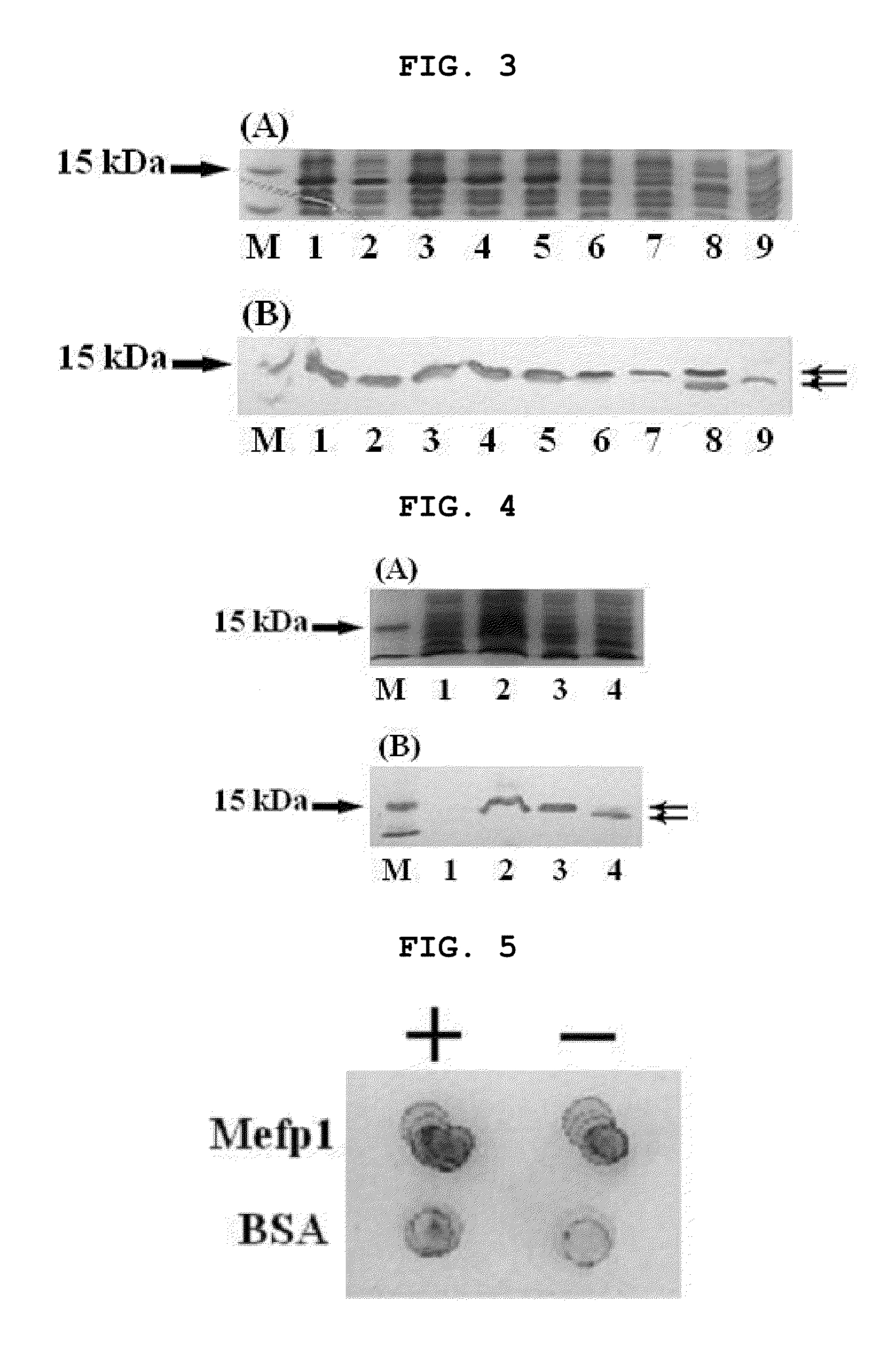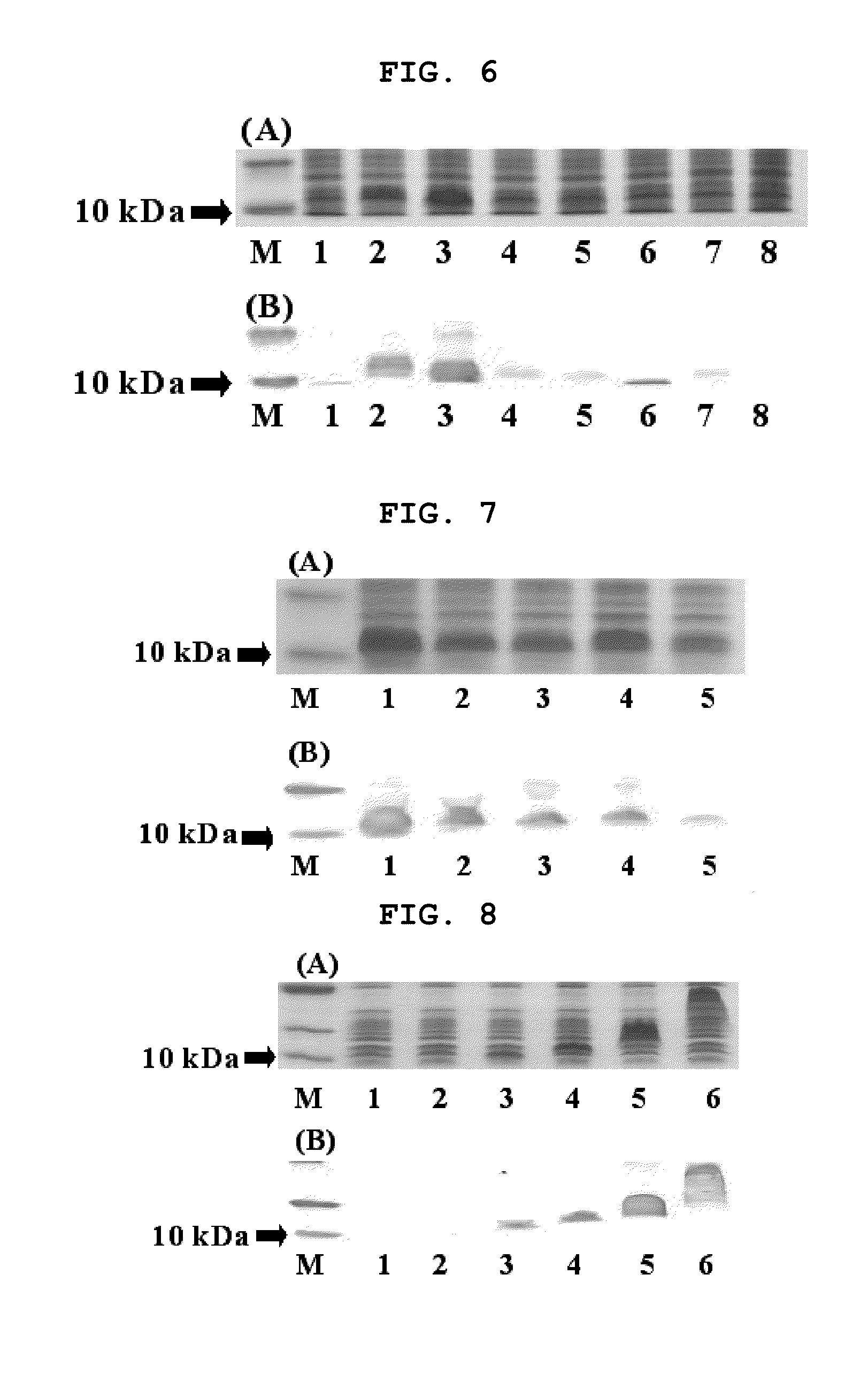Production of a soluble native form of recombinant protein by the signal sequence and secretional enhancer
a technology of signal sequence and enhancer, which is applied in the direction of peptides, drug compositions, metabolic disorders, etc., can solve the problems of difficult to produce the native form of a recombinant, the inability to predict the production of a protein in soluble form, and the misfolding and aggregate of expressed proteins
- Summary
- Abstract
- Description
- Claims
- Application Information
AI Technical Summary
Benefits of technology
Problems solved by technology
Method used
Image
Examples
example 1
Cloning of an Adhesive Protein Gene DNA Multimer Cassette
[0224]The present inventors prepared a synthetic mefp1 DNA based on the basic unit of the Mefp1 amino acid sequence represented by SEQ. ID. NO: 1 (Ala Lys Pro Ser Tyr Pro Pro Thr Tyr Lys) by using a forward primer represented by SEQ. ID. NO: 2 (5′-TAC AAA GCT AAG CCG TCT TAT CCG CCA ACC-3′) and a reverse primer represented by SEQ. ID. NO: 3 (5′-TTT GTA GGT TGG CGG ATA AGA CGG CTT AGC-3′). For the left adaptor (referred as “La” hereinafter) synthetic DNA (contains BamHI / EcoRI / SmaI), a forward primer represented by SEQ. ID. NO: 4 (5′-GAT CCG AAT TCC CCG GG-3′) and a reverse primer represented by SEQ. ID. NO: 5 (5′-TTT GTA CCC GGG GAA TTC G-3′) were used. For the right adaptor (referred as “Ra” hereinafter) synthetic DNA (contains Arg / HindIII / SalI / XhoI), a forward primer represented by SEQ. ID. NO: 6 (5′-TAC AAA CGT AAG CTT GTC GAC C-3′) and a reverse primer represented by SEQ. ID. NO: 7 (5′-TCG AGG TCG ACA AGC TTA CG-3′) were us...
example 2
Expression of an Adhesive Protein mefp1
[0236]In the previous study, Mefp1 expressed an insoluble inclusion body when Met-Mefp1 was used as a leader sequence (Kitamura et al., J Polym. Sci. Ser. A 37:729-736, 1999). The present inventors introduced the signal sequence OmpASP (OmpA signal peptide) to induce expression of a target protein in soluble form, for which PCR was performed using the mefp1 sequence of FIG. 2 as a template to construct a clone harboring different sizes of ompASP and the mefp1 cassette (Table 1).
[0237]Transformants of E. coli BL21(DE3) generated by using the expression vector containing the signal sequence shown in Table 1 were cultured in LB medium (tryptone 20 g, yeast extract 5.0 g, NaCl 0.5 g, KCl 1.86 mg / l) in the presence of 50 μg / ml of ampicillin at 30° C. for 16 hours. The culture solution was diluted 200-fold with LB medium. The diluted culture solution was incubated to reach OD600 of 0.3 and then IPTG was added to a final concentration of 1 mM. The cul...
example 3
Production of the Native Form of an Adhesive Protein mefp1
[0239]To produce Mefp1 with its native N-terminus, the present inventors performed PCR using pBluescriptIISK(+)-La-7×mefp1-Ra (FIG. 2) as a template and a synthetic oligonucleotide encoding the OmpASP1-8-Xa-Mefp1 containing factor Xa cleavage site for cleaving the C-terminal end as a forward primer to construct pET-22b(+)(ompASP1-8-Xa-7×mefp1*) (*: Ra-6×His, Ra derived from the right adaptor; 6×His derived from His tag) clone, based on the result of soluble expression by the shortened OmpASP (Table 1). The constructed vector was tested for the expression by the transformation and Western blotting as described in Example 2.
[0240]As a result, this clone produced soluble protein OmpASP1-8-Xa-7×Mefp1*. Further, the 7×Mefp1* protein with a native amino acid terminus was obtained by the removal of the OmpASP1-8-Xa sequence with factor Xa protease (FIG. 4).
[0241]To modify the signal sequence region of the above clone conveniently, t...
PUM
| Property | Measurement | Unit |
|---|---|---|
| Fraction | aaaaa | aaaaa |
| Length | aaaaa | aaaaa |
| Volume | aaaaa | aaaaa |
Abstract
Description
Claims
Application Information
 Login to View More
Login to View More - R&D
- Intellectual Property
- Life Sciences
- Materials
- Tech Scout
- Unparalleled Data Quality
- Higher Quality Content
- 60% Fewer Hallucinations
Browse by: Latest US Patents, China's latest patents, Technical Efficacy Thesaurus, Application Domain, Technology Topic, Popular Technical Reports.
© 2025 PatSnap. All rights reserved.Legal|Privacy policy|Modern Slavery Act Transparency Statement|Sitemap|About US| Contact US: help@patsnap.com



